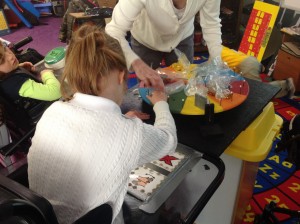My Kenan lessons, which were related to Matter, Property and Change, went well. My students enjoyed the hands-on activities such as a lesson named, ‘Let’s Bake a Change’. To begin, I read a story called, Whopper Cake by Karma Wilson. After we completed that section, the students and their partners baked cupcakes to identify the concept of baked versus not baked. They responded well to a game where we used a spinner to select items to show if the pictures of items were baked or not baked.
I have learned so much from the in-depth work involved in creating lessons to address science topics as related to students with severe disabilities and deaf-blindness. I try my best through all of my lessons to incorporate communication skills to allow the students to initiate communication. Students in my class are all non-verbal so they all have alternate means of communicating. I have attached example of some of the voice output devices they use. Since I use the North Carolina Extended Content Standards to address academic skills (an adapted version of the NC Essential Standards), I try my best to have the lessons related to science but also related to real life situations to help them generalize the topics.
In addition to the communication adaptations, I ensure that there are adaptations for those students who are deaf/blind. For example, in my lesson called “Through Thick and Thin”, I made sure to include hands-on materials of bags with of liquids with a variety of thick and thin liquids. The students each had a marble in the bags and they were able to feel the liquids in the bags and tell whether the marble moved fast or slow through the liquid in the bag. In my area of teaching, there are few ideas and options available for teaching science to students with severe disabilities. It is hard to also find ideas of how to get parents involved in their child’s education. In each of my lessons, I included ideas of how the science lessons can carry over to home. I am in the process of creating videos for parents to show them how to teach the same skills we use at school.
In the attached pictures, I used a homemade spinner that my son built to use as a choice making opportunity for classroom lessons. In the lesson, we had been learning about the difference between solids and liquids. The students helped move the spinner to make their choice of a solid or liquid. They then worked with a partner to experiment and identify whether the item was solid or liquid. After that, they made a sentence and took pictures of the process. As a class, we made a PowerPoint book about the experiment. In the picture below, a student is using an adapted device to turn the pages on the newly student-created electronic book.
Solids or Liquids Classmade book 3-14
In order to create inclusive situations with students from the general education classes, I also gave ideas of how teachers can include students from all levels of learning. In one of my lessons, I was able to use it as an inclusive lesson. The students all enjoyed working together. Activities such as this are very effective in helping the general education students understand my students. It is also very helpful with my students in that it gives them great opportunities to practice communication with others.
I have thoroughly enjoyed the Kenan experience and have changed the way I write and think through my lesson plans as a result of creating the Kenan Unit Plan. I truly appreciate this opportunity!

